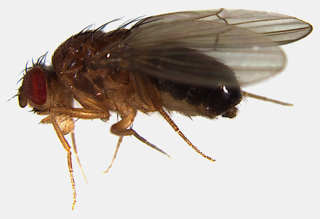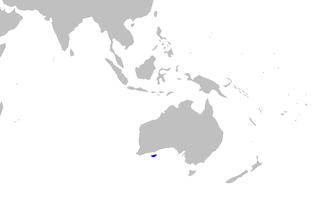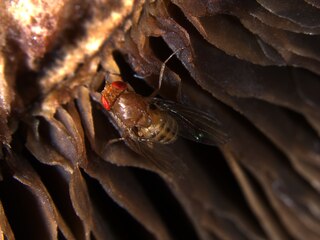
Drosophila is a genus of flies, belonging to the family Drosophilidae, whose members are often called "small fruit flies" or pomace flies, vinegar flies, or wine flies, a reference to the characteristic of many species to linger around overripe or rotting fruit. They should not be confused with the Tephritidae, a related family, which are also called fruit flies ; tephritids feed primarily on unripe or ripe fruit, with many species being regarded as destructive agricultural pests, especially the Mediterranean fruit fly.

Drosophila melanogaster is a species of fly in the family Drosophilidae. The species is often referred to as the fruit fly or lesser fruit fly, or less commonly the "vinegar fly" or "pomace fly". Starting with Charles W. Woodworth's 1901 proposal of the use of this species as a model organism, D. melanogaster continues to be widely used for biological research in genetics, physiology, microbial pathogenesis, and life history evolution. As of 2017, five Nobel Prizes have been awarded to drosophilists for their work using the insect.

Allopatric speciation – also referred to as geographic speciation, vicariant speciation, or its earlier name the dumbbell model – is a mode of speciation that occurs when biological populations become geographically isolated from each other to an extent that prevents or interferes with gene flow.

Polytene chromosomes are large chromosomes which have thousands of DNA strands. They provide a high level of function in certain tissues such as salivary glands of insects.

Drosophila funebris is a species of fruit fly. It was originally described by Johan Christian Fabricius in 1787, and placed in the genus Musca but is now the type species of the paraphyletic genus Drosophila. Drosophila funebris is a member of the Immigrans-tripunctata radiation of the subgenus Drosophila.

The Drosophilinae are the largest subfamily in the Drosophilidae. The other subfamily is the Steganinae.

The paraphyletic subgenus Sophophora of the genus Drosophila was first described by Alfred Sturtevant in 1939. It contains the best-known drosophilid species, Drosophila melanogaster. Sophophora translates as carrier (phora) of wisdom (sophos). The subgenus is paraphyletic because the genus Lordiphosa and the species Hirtodrosophila duncani are also placed within this subgenus.
The mechanisms of reproductive isolation are a collection of evolutionary mechanisms, behaviors and physiological processes critical for speciation. They prevent members of different species from producing offspring, or ensure that any offspring are sterile. These barriers maintain the integrity of a species by reducing gene flow between related species.

Cupressus funebris, the Chinese weeping cypress, is a species of cypress native to southwestern and central China. It may also occur naturally in Vietnam.

Asymbolus funebris, or blotched catshark, is a catshark of the family Scyliorhinidae, the only specimen, the holotype, being found off Western Australia at 144 m. Its length is 44 cm and its reproduction is oviparous.

The green moray is a moray eel of the family Muraenidae, found in the western Atlantic Ocean from Long Island, New York, Bermuda, and the northern Gulf of Mexico to Brazil, at depths down to 40 metres (130 ft). Its length is up to 2.5 metres (8.2 ft).

The sombre kingfisher is a species of bird in the family Alcedinidae. It is endemic to island of Halmahera, in North Maluku, Indonesia.

The slate-colored boubou or slate-coloured boubou is a species of bird in the family Malaconotidae. It is found in Ethiopia, Kenya, Rwanda, Somalia, South Sudan, Tanzania, and Uganda. Its natural habitats are subtropical or tropical dry forests, dry savanna, subtropical or tropical dry shrubland, and subtropical or tropical moist shrubland.

The immigrans-tripunctata radiation is a speciose lineage of Drosophila flies, including over 300 species. The immigrans-tripunctata radiation is a sister lineage to most other members of the subgenus Drosophila. A number of species have had their genomes or transcriptomes sequenced for evolutionary studies using Drosophila.

Drosophila is a paraphyletic subgenus of the genus Drosophila, a classification of fruit flies. This subgenus was first described by Alfred Sturtevant in 1939. Members of the subgenus Drosophila can be distinguished from other Drosophilid species by breaks in the pigmentation along the dorsal section of their abdomen.

Drosophila subobscura is a species of fruit fly in the family Drosophilidae. Originally found around the Mediterranean, it has spread to most of Europe and the Near East. It has been introduced into the west coasts of Canada, the United States, and Chile. Its closest relative is Drosophila madeirensis, found in the Madeira Islands, followed by D. guanche, found in the Canary Islands. These three species form the D. subobscura species subgroup. When they mate, males and females perform an elaborate courtship dance, in which the female can either turn away to end the mating ritual, or stick out her proboscis in response to the male's, allowing copulation to proceed. D. subobscura has been regarded as a model organism for its use in evolutionary-biological studies.

The Drosophila testacea species group belongs to the Immigrans-tripunctata radiation of the subgenus Drosophila, and contains 4 species: Drosophila putrida, Drosophila neotestacea, Drosophila testacea, and Drosophila orientacea. Testacea species are specialist mushroom-feeding flies, and can metabolize toxic compounds in Amanita mushrooms. The Testacea species group is studied for its specialist ecology, population genetics, and bacterial endosymbionts. The North American species Drosophila neotestacea is perhaps the best-studied of the group for its interactions with parasitic wasps and nematodes, bacterial endosymbionts, and trypanosomatid parasites. Of note, selfish X chromosomes have been discovered in three of the four Testacea group species.

Mushroom-feeding Drosophila are a subset of Drosophila flies that have highly specific mushroom-breeding ecologies. Often these flies can tolerate toxic compounds from Amanita mushrooms.

Drosophila silvestris is a large species of fly in the family Drosophilidae that are primarily black with yellow spots. As a rare species of fruit fly endemic to Hawaii, the fly often experiences reproductive isolation. Despite barriers in nature, D. silvestris is able to breed with D. heteroneura to create hybrid flies in the laboratory.

The Hawaiian Drosophilidae are a lineage of flies within the genus Drosophila. This monophyletic clade includes all of the endemic Hawaiian Drosophila and all members of the genus Scaptomyza, which contains both Hawaiian and non-Hawaiian species. The Hawaiian Drosophilidae are descended from a common ancestor estimated to have lived 25 million years ago. Species of Hawaiian Drosophilidae flies have been studied as models of speciation and behavioral evolution. Along with other members of the native Hawaiian ecosystem, the conservations status of many species of Hawaiian Drosophilidae is threatened by habitat loss and introduced predators, among other factors.
















